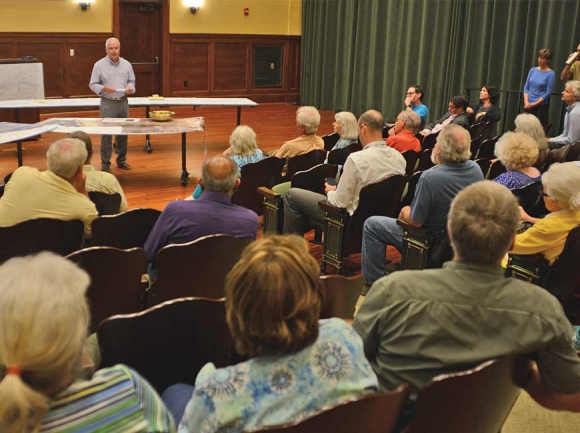Sylva business community organizes against N.C. 107 plans
 Jay Coward addresses community members at the June 26 revival of the Jackson County Smart Roads Alliance. Holly Kays photo
Jay Coward addresses community members at the June 26 revival of the Jackson County Smart Roads Alliance. Holly Kays photo
Dismay over preliminary road construction plans that would force 54 Sylva businesses to relocate has sparked a revival of the Jackson County Smart Roads Alliance, the group that in the early 2000s fought off N.C. Department of Transportation plans to build a new highway — dubbed the Southern Loop — connecting Cullowhee to U.S. 74.
“We’ve done it before and we can do it again, so if you want to be part of this process and preserve your community and redesign it in such a way that we can build a good, smart road, now’s the time to join up,” Sylva attorney Jay Coward told a group of about 50 Sylva residents and business owners gathered at the Jackson County Public Library June 26.
It’s no secret that Sylva has a traffic problem, particularly along the five-lane road that runs from U.S. 74 down U.S. 23 to the Rite-Aid and then left along N.C. 107 to Western Carolina University. Town and transportation officials have been trying to crack that nut for decades, and now the DOT is expecting to actually start construction on the answer in 2020.
The only problem? According to preliminary plans completed this spring, construction would force 54 businesses, one nonprofit and five residences to relocate. That equates to roughly one-sixth of the total number of businesses registered in Sylva.
“We don’t understand any of this concept because you’ve still got the same amount of lanes, and nobody rides bikes,” said Deanie Edwards, who owns Ted’s Laundromat and attended the June 26 Smart Roads Alliance kickoff meeting. “They’re going to make a bike path and take our parking, take our livelihoods, knock some buildings down — we don’t get it.”
Related Items
Imagining a better plan
Others in the room certainly shared Edwards’ sentiment, but the purpose of the meeting was not to vent anger and frustration at DOT. The meeting was instead an opportunity to learn more about DOT’s current proposal, how that might affect local businesses, and what the community could do to change the project’s trajectory.
“This is not the final plan,” said Coward. “That’s good news, because this means we have input at this time and we can actually have a say-so about what’s happening, but I want you to understand that right now their proposal, if we don’t say anything at all, is going to go in like it is on this piece of paper.”
According to Coward, that would prove detrimental to Sylva. In addition to bulldozing existing businesses to realign portions of the road and build new features like bike lanes and wider sidewalks, new curbs and retaining walls would have significant implications even for businesses whose structures would not be directly affected. By Coward’s calculations, 22 of the 54 businesses on the list for relocation would be completely demolished, with the remaining businesses seeing impacts ranging from a decrease in parking to partial loss of a structure. As the plans stand now, all of the businesses, homes and nonprofits on the list would be “impacted to the point they’re no longer viable to conduct the business that’s being conducted there today,” said DOT division engineer Brian Burch, though it’s possible some type of commercial use could continue on some of the parcels.
“It’s a matter of how much of an internal organ you can remove from your body before your body dies, and that’s what is going to happen to some of these businesses,” Coward said. “They’ll be so hurt by it they won’t be able to survive.”
However, he told the group, there might be another way, and Asheville-based nonprofit MountainTrue could help find it.
“My experience with DOT is that sometimes they don’t come up with the most creative solutions to things,” said Julie Mayfield, co-director of MountainTrue.
By engaging with engineers who have experience in this kind of creative road planning, including Chris Joyell, director of MountainTrue’s Asheville Design Center, the group could come up with a better plan than the one DOT currently has on the table, Mayfield said.
The placement of bike lanes is a good example, she said. Bike lanes are required due to the state’s Complete Streets policy, adopted in 2009, but adding them will mean widening the roadway and have a considerable impact on the right-of-way needed for the project. What if bike lanes and sidewalks ran behind the businesses rather than in front of them? Such an arrangement would keep the roadway narrower, lessening the impact on existing businesses, and result in a more enjoyable place for cyclists to ride.
“I can’t guarantee you that’s the solution we could come up with, but that’s what we want to try,” Joyell told the group.
The tone of Coward’s, Mayfield’s and Joyell’s presentations was calm and informational, but they found it difficult at times to prevent the meeting from turning into an all-out venting session against the DOT.
“So build bike lanes on the field of dreams premise? Build it and maybe they’ll ride?” asked Charlie Schmidt, general manager at Speedy’s Pizza. “Ruin people’s livelihoods so somebody can ride bikes?”
Speedy’s Pizza sits along West Main Street — the most visible traffic problem is on East Main Street — and he’s been advocating for that section of road to be left off the project docket, launching a petition to that effect that now has about 1,000 signatures. Speedy’s has operated out of its current location for more than 30 years but would be slated for relocation according to the current plans.
“You’re talking about the problem is the traffic,” said Dominique Olivarez, who owns AlienFix Phone Repair. “I’m from a bigger city. Coming from Florida, I know what traffic is. The traffic here is two minutes and that’s it. It’s a joke for you guys to kill our business. I think you don’t care about us.”
“We’re not DOT. We’re on your side,” Mayfield was quick to respond.
She then offered some options for the road ahead. While it’s probably not possible to kill the project — after decades of talk, it’s been funded, with most everybody agreeing that something has to be done to make N.C. 107 safer — Mayfield was heavy on hope that the final product could end up being much more friendly to Sylva’s business community.
“So this does happen across the country, where big, five-lane, almost expressway-like roads like this get turned into beautiful places and actually become better for business,” said Mayfield. “I know it is so hard to imagine. But it does happen.”
A project with history
The current DOT plans show a project that would drastically affect a large proportion of Sylva businesses and make it harder for customers to stop by local establishments due to controlled access — there would no longer be a driveway at every business, with turns permitted only at specified locations.
But the plans are far from being hastily-drawn sketches sent off with no thought of the implications. And at 25 percent complete, they’re also far from final.
“There’s a lot of history in the project as far as how we’ve gotten to this point in the plan,” said Sylva Town Manager Paige Dowling. “Roundabouts have been explored, more intersections have been explored, a bypass has been discussed, but ultimately this is the road that we have and we know that it’s not safe and doesn’t meet the current traffic volume.”
Talk about what to do with N.C. 107 has been going on since the 1990s. Originally, the road was built as a connector between Sylva and Cullowhee — a wide, open road with few, if any, driveways. Over time, the area became more developed, businesses located along the corridor, Western Carolina University began to grow, and a traffic issue was born.
Originally, the DOT’s concept was to build the Southern Loop, a bypass that would connect Cullowhee to U.S. 74 without funneling traffic all the way up to Sylva. In 2002 the Smart Roads Alliance formed in response to that plan, decrying the astronomical expense, environmental damage and harm to Sylva’s downtown economy they expected the project would cause. Eventually, the group won. DOT axed its plans for a bypass and instead aimed to improve the existing roads — namely, N.C. 107.
The problem is that N.C. 107 serves as the main commercial corridor for Sylva, and due to topographical constraints, most businesses are built right up along the road. The goal may be to improve the road without hurting existing businesses, but logistically there’s just not much space to work with.

Speedy’s Pizza and the Valero Gas Station & Convenience Store (above) are both on the N.C. Department of Transportation’s preliminary list of businesses that could be displaced.
“There’s very little opportunity for us to deliver this project and not have significant impacts, and while we can try to address the amount of impacts, it’s very difficult just due to the way those commercial properties are developed. They come right up to the existing roadway now, to the back of the curb in many cases,” Burch said.
“We know it’s going to be painful and there are going to be impacts,” Dowling added. “We’d like to have those impacts be as few as possible, but we realize the road needs improvements.”
In 2017 alone, Dowling said, there were 220 accidents on U.S. 23 and N.C. 107 in the proposed project area.
Nevertheless, Coward believes there are many opportunities to tweak the plans and avoid unnecessary property condemnations. He pointed out a U-turn turnout that will require condemnation of a business when there’s vacant lot just next door, a bridge relocation that will require realigning the road and mowing through several businesses, and other instances where he believes small changes could have big payoffs for locals.
“We’re very much willing to sit down and discuss their concerns and how they feel like we can make adjustments,” said Burch.
However, he said, it’s important to note that the plans are only 25 percent complete and could change substantially once Duke Energy provides its utility plans for the corridor. Those aren’t expected until December.
“It’s really premature to start trying to adjust the plans until we have all the information we need,” said Burch.
Burch added that the DOT considers the town of Sylva and the Southwestern Rural Planning Organization as its partners in the project. Those entities will have to be on board with any proposed changes. The Sylva town board has not yet discussed the proposal or the resurrection of the Smart Roads Alliance as a group.
And there’s another wrinkle, too. When it comes to dollars and cents, not all road projects are created equal. If, for instance, Mayfield’s suggestion of running sidewalks and bike lanes behind the businesses proved possible, the next question would be how much it would cost compared to the proposal currently under consideration.
“Once you get outside of the scope of what’s being discussed and planned and the project that was identified, we start having to limit our capacities to fund and partner on those types of improvements, but we’re willing to talk about them, and I think it’s worthwhile to talk about them,” Burch said.
One thing is certain, though: improvements are coming to N.C. 107.
“DOT is committed to delivering the project,” Burch said.
Get involved
MountainTrue is serving as the treasurer for the Jackson County Smart Roads Alliance, with funds raised to cover fees for professionals needed to help with the planning effort, along with other miscellaneous costs. Guidance from MountainTrue’s Design Center is free.
Donate online at www.mountaintrue.org/join and specify that the donation is for the Smart Roads Alliance. For more information or to join the Smart Roads Alliance, contact Jay Coward at This email address is being protected from spambots. You need JavaScript enabled to view it..









